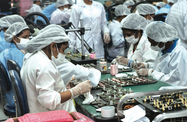Rising demand and expectations of stronger sales should sustain growth in Sri Lankan manufacturing in 2017, though labour shortages will need to be addressed to maintain this trajectory.

The latest purchasing managers’ index (PMI) released by Sri Lanka’s central bank showed continued expansion in manufacturing, which stood at 56.2 points in January; any PMI reading above 50 indicates growth.
Since the central bank began producing monthly PMI data in May 2015, the manufacturing index has been largely positive, dipping into negative territory only in April and May of last year – partly a result of adverse weather conditions – before rebounding strongly.
While January’s figure was down slightly on the 58.3 points posted in December – a dip the central bank attributed to seasonal factors such as realignment of business plans in the new year – results were well up on the same month in 2016, when the index stood at 51.9.
All five indices included in the PMI showed positive year-on-year growth. Month-on-month increases were seen on the employment and stock purchases indices, suggesting higher levels of production and new orders could be seen in the near future.
“Overall data points to an expansion where all the sub-indices are above the neutral 50 threshold,” the central bank said. “The expectations for activities indicated an improvement for the next three months.”
The IMF is similarly bullish on manufacturing growth. In a December review of its three-year extended fund facility with the Sri Lankan government, the IMF forecast GDP would expand by 6.3% this year, above the 5-5.5% expected in 2016. Manufacturing is seen as a key driver of this growth, and the IMF predicts it will see increases in the coming year along with construction and services.

Quality over quantity
High-end and specialised manufacturers in particular could post above-average results, as quality, not necessarily quantity, is the strong suit of Sri Lanka’s industrial base, according to Chandana Dissanayka, managing director of local electronics manufacturer Variosystems. By utilising talent and identifying key products and markets, he said, local industry can thrive.
“Sri Lanka doesn't have the economies of scale to compete head on with other, larger industrial manufacturing hubs like India,” he told OBG. “However, we are fortunate to be have a deep talent pool of human capital, which enables the country to compete higher up on the value chain in niche export markets.”
Aruna Deepthikumara, CEO of chemical company BASF Lanka, agrees that the ability to produce premium-quality goods can give local manufacturers an edge, both for their home markets and regional ones.
“Sri Lanka is a relatively small market but offers quality in terms of product engineering, in addition to being the highest value growth market in South Asia,” he told OBG.
Labour pool
While Sri Lanka has a highly skilled workforce, recent studies have shown this talent base will need to be broadened in order to keep pace with growing demand for manufactured goods.
Though well-placed for many specialist personnel, many segments of manufacturing are struggling to fill vacancies. While unemployment is low, at around 4%, according to the IMF, the jobless rate among youth is much higher, with some estimates putting it above 20%.
According to a study conducted by Athula Ranasinghe, dean of the University of Colombo’s Faculty of Arts, there is a widespread shortage of skilled and semi-skilled labour in many Sri Lankan industries: up to one-third in manufacturing and far higher in textiles.
There have been calls for greater state investment in vocational training and encouragement for more women to enter the workforce to help expand the labour pool, which otherwise could face a widening skill gap as the sector expands.
Labour shortages could also feed wage inflation in the manufacturing sector, thereby raising the cost of production and potentially prices for end consumers. Consumer inflation is already rising, having jumped from 4.2% in December to 6.5% in January on higher food prices caused by drought.
Opening trade doors
Sri Lanka’s government has been working to adhere to stipulations set by the EU’s General System of Preferences Plus (GSP+), duty concessions that could provide a further boost to manufacturing by lowering barriers to trade.
If the European Parliament approves Sri Lanka’s bid to join GSP+, the EU would remove tariffs imposed on products covered by the plan. A decision is expected on May 15. As a beneficiary of the GSP+ scheme, Sri Lanka would open its doors to duty-free trade with Europe’s single market, fuelling increased demand for its products and lifting exports.
Reforms required to take part in the preferential tariff programme include adherence to international standards on human rights, labour rights, environmental protection and good governance.



